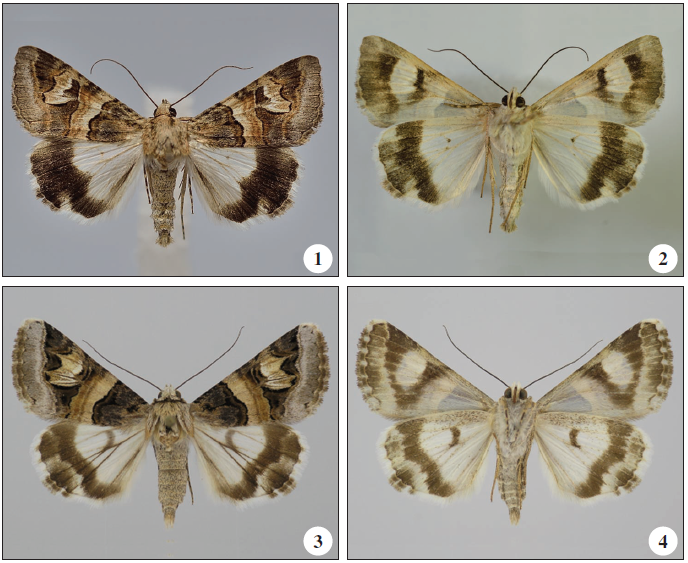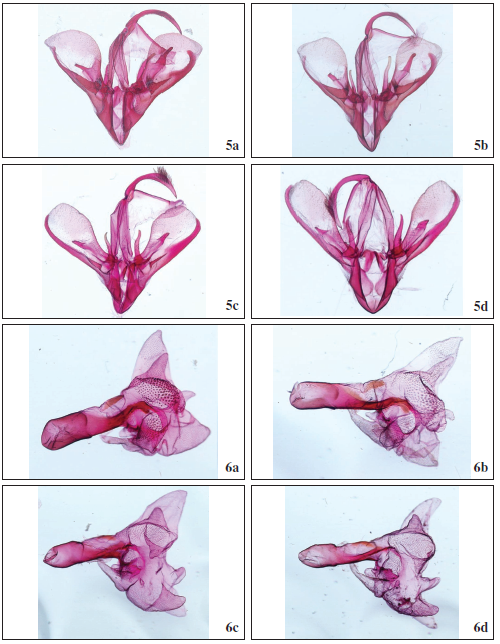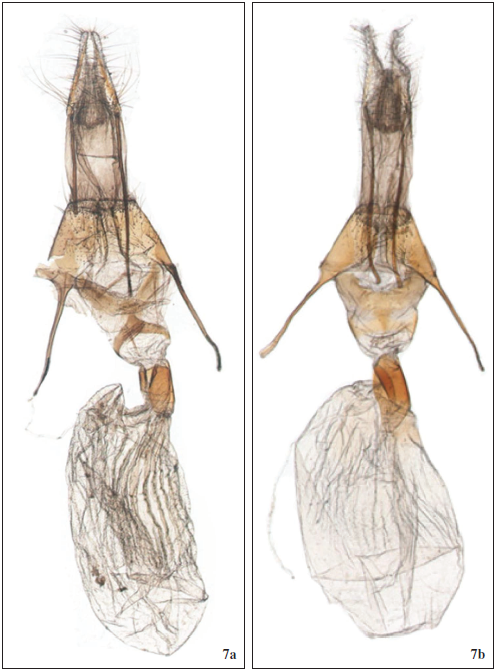

Drasteria philippina (Austaut, 1880) a new record for the Maltese Islands and Europe (Lepidoptera: Erebidae)
Drasteria philippina (Austadt, 1880) una nueva especie para Malta y Europa (Lepidoptera: Erebidae)
Drasteria philippina (Austaut, 1880) a new record for the Maltese Islands and Europe (Lepidoptera: Erebidae)
SHILAP Revista de Lepidopterología, vol. 47, núm. 185, 2019
Sociedad Hispano-Luso-Americana de Lepidopterología
Recepción: 23 Agosto 2018
Aprobación: 25 Septiembre 2018
Publicación: 30 Marzo 2019
Abstract: Drasteria philippina (Austaut, 1880) is here recorded for the first time from the Maltese Islands and from Europe. Differences between Drasteria philippina from North Africa and Drasteria cailino (Lefèbvre, 1827) from France and Greece is here depicted and discussed.
Keywords: Lepidoptera, Erebidae, Drasteria philippina, Maltese Islands.
Resumen: Drasteria philippina (Austaut, 1880) se cita por primera vez para Malta y Europa. Aquí son tratadas y discutidas las diferencias entre Drasteria philippina del norte de África y Drasteria cailino (Lefèbvre, 1827) de Francia y Grecia.
Palabras clave: Lepidoptera, Erebidae, Drasteria philippina, Malta.
Introduction
The lepidopteran fauna of the island of Malta is rather diverse, despite its small territory and strong isolation due to its location being far from the coasts of both Europe and North Africa. The most comprehensive checklists of the Lepidoptera of the Maltese Islands are published by VALLETTA (1973) and SAMMUT (2000). The subsequent faunistical surveys led to the discovery of the existence or appearance of several further species belonging to various families, e. g. Noctuidae, Geometridae and Pyralidae, with a recent increase of new findings.
One of these new discoveries is the observation of Drasteria philippina (Austaut, 1880) in Malta, a species typical of the North African semi-arid habitats. Both the genus and species are new to the Lepidoptera fauna of the Maltese Islands, and this is the first record of the species from Europe. Material of D. cailino (Lefèbvre, 1827) from Greece, France and Morocco were compared with the Maltese Drasteria and the comparison showed that the Maltese specimen undoubtedly belongs to D. philippina. The genitalia preparations of D. philippina and D. cailino are illustrated, displaying the clear differences between the two species in the clasping apparatus, the configuration of the vesica and the antrum and ductus bursae as well (see the Figs 5-7).
I propose the Maltese name “Drasteria Sabieha” after its beautiful shape and colours. The details of the observation, the characterisation of the species and the comparison with its closest related sibling taxon, D. cailino (Lefèbvre, 1827), is provided below.
Material Examined
Drasteria philippina (Austaut, 1880): MALTA: 1 1, Zebbug, 31-III-2018, at light, leg. A. Catania; slide No. RL12450m (coll. A. Catania). MOROCCO: 1 1, Mediterranean Coast, 3 km W Kala-Iris, 100 m, 4º 21’W, 35º 20’N, 19-IV-1994, leg. Gy. M. László (Drasteria philippina, det. A. Matov); slide No. RL12453m (coll. HNHM Budapest). TUNISIA: 1 0, Thyna, seacoast, 7-IV-1977, leg. L. Gozmány & S. Mahunka, slide No. RL460f (coll. HNHM Budapest).
Drasteria cailino (Lefèbvre, 1827): FRANCE: 1 1, Basses Alps, Chateauredon, 700 m, 14-27-V-1974, leg. Ströhle, slide No. RL12452m; 1 0, Basses Alps, Digne, 22-VII, coll. Wagner, slide No. RL461f. GREECE: Smolikas, Paraskevi, 800 m, 10-VII-1989, leg. Stengel; slide No. RL12451m (all in coll. HNHM Budapest).

Discussion
The observation of Drasteria philippina (Austaut, 1880) in the Maltese islands is very remarkable. If this phenomenon is a cause of global warming one cannot be so sure, but it is a fact, that recently, records of Lepidoptera from the North African continent have constantly been recorded from the Maltese islands. Since a few years back the Desert Babul Blue Azanus ubaldus (Cramer, 1782) (CATANIA et al., 2017), Bocchoris bleusei (Oberthür, 1887) (CATANIA, 2017) and Isturgia disputaria (Guenée, 1858) (CATANIA, 2010) have been recorded as making their way to the Maltese Islands on windy days blowing from the South. Drasteria philippina was also recorded during a night with very strong winds blowing from the South West of the Maltese Islands.
The distributional range of Drasteria philippina extends from Morocco throughout the African Mediterranean and the northern parts of the Sahara (Algeria, Libya, to Egypt, and the Israel’s Negev desert) (AUSTAUT, 1880).
At first glance, D. philippina and D. cailino look very similar. Austaut in 1880 figured Drasteria philippina in plate 2, fig. 13 where he mentions this moth to fly especially in semi-arid temperate biotopes but absent from the actual deserts. It is argued that a false report from Tassili-n-Ajjer plateau in south-east Algeria could be possible. WARREN (1914, in SEITZ) depicted an image of Drasteria philippina. The same image corresponds with the picture depicted in GOATER et al., 2003.
The two species can hardly be distinguished by their external features. However, the inner area of the hindwing is clearer milky-white in D. philippina, most often without the dark covering of veins which is typical of D. cailino and the discal spot is smaller or obsolete than in its sister-species (see the Figs 1-4). These features are better visible in the females where the inner area of the hindwing of D. philippina is usually entirely white, without dark markings. The proper identification requires, however, the study of the genitalia which show easily recognisable differences in both sexes. In males, D. philippina has, in comparison with D. cailino (see the figs 5-6 and GOATER et al., 2003: fig. 32), 1) longer, slenderer, medially not dilated uncus with weak dorsal setose area; 2) more dilated distal (apical) sections of both valvae with somewhat angulate ventral edge; 3) shorter and stronger ventral saccular extensions with more curved terminal parts; 4) strongly asymmetrical ampullar processes, being much longer (ca twice as long) and thinner on right valva; 5) larger and longer, more acute digitus on right valva; 6) larger editum on both sides, with conspicuously stronger developed apical setose fields; and 7) differently shaped and sized diverticula on the vesica, with much stronger scobination medially. In D. cailino, the uncus is shorter, more curved and medially stronger dilated, with well-developed dorsal setose area; the distal (apical) sections of both valvae are less dilated and more or less evenly rounded; the ventral saccular extensions are longer and less curved, following the ventral edges of the valval plates; the ampullar processes are more or less equal in size; the digitus of the right valva is remarkably shorter and thinner than in D. philippina; the editum is smaller, weaker and less setose on both valvae; while the differently shaped and sized diverticula on the vesica are generally less scobinate than in D. philippina.
n the female genitalia, the sclerotised reversed Y-shaped plate of the distal part of ductus bursae is much stronger in D. philippina and the sclerotised proximal section of ductus bursae is proportionally shorter than in D. cailino (see the fig. 7 and GOATER et al., 2003: fig. 130).
The life history of Drasteria philippina is not well known and the larvae are only mentioned by AUSTAUT (1880: 237) saying that previously he had reared green larvae for the type he had studied, but “his brother Edouard reared beautiful bluish grey and slightly a little on the purple caterpillars”. These produced big remarkable moths (AUSTAUT, 1880). The food plant(s) of D. philippina is / are not known so far and if the possibility to rear this moth arises, one could determine what the early stages would feed on only by trial and error. Its twin species D. cailino feeds on Salix viminalis and Rosa canina, two food plants that do not grow in the natural habitat in the Maltese Islands (HASLAM & WOLSELEY, 1977).


Agradecimientos
I would like to show my gratitude and thanks to Dr. László Ronkay for the genitalia preparation, comparison and confirmation of the species. Also, thanks for the availability of specimens from the Hungarian National History Museum and pictures of the specimens of Drasteria cailino (Lefebvre, 1827). Finally, my thanks go to Dr. Antonio Vives for the Spanish text and acceptance of this publication.
Referencias
AUSTAUT, J. L., 1880.– Lépidoptères nouveaux d’Algérie.– Le Naturaliste, 2(30): 220-221, 237.
CATANIA, A. & SEGUNA, A., 2017.– On the Occurrence of the Azanus ubaldus (Stoll, 1782) in the Maltese Islands (Lepidoptera: Lycaenidae).– SHILAP Revista de lepidopterología, 45(178): 213-216.
CATANIA, A., 2010.– Isturgia disputaria (Guenée, 1858), a species new to the Lepidoptera fauna of the Maltese Islands (Lepidoptera: Geometridae, Ennominae).– SHILAP Revista de lepidopterología, 38(151): 287-289.
CATANIA, A., 2018.– Bocchoris bleusei (Oberthür, 1887) a new species for the Maltese Islands (Lepidoptera: Crambidae).– SHILAP Revista de lepidopterología, 46(181): 173-175.
GOATER, B., RONKAY, L. & FIBIGER, M., 2003.– Noctuidae Europaeae. Catocalinae & Plusinae, 10: 455 pp +16 pls. Entomological Press, Sorø.
HASLAM, S. M. & WOLSELEY, P. A., 1977.– A Flora of the Maltese Islands: 560 pp. Malta University Press. Msida.
ROTHSCHILD, L., 1915.– Lepidoptera of the M’Zab Country, South Algeria, collected by Dr. Ernst Hartert and Carl Hilgert in 1914.– Novitates Zoologicae, 22(2): 228-243.
SAMMUT, P., 2000.– Kullana Kulturali. 12-Il-Lepidoptera: 246 pp.– Pubblikazzjonijiet Indipendenza, Valleta.
VALLETTA, A., 1973.– The Moths of the Maltese Islands: 120 pp. Progress Press, Valletta
WARREN, W., 1914.– Die Palaearktischen Eulenartigen Nachtfalter.– In A. SEITZ (ed.) (1909-1914). Die Großschmetterlinge des Palaearktischen Faunengebietes, 3: pl. 70i. Alfred Seitz, Kernen Verlag.